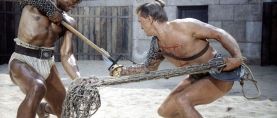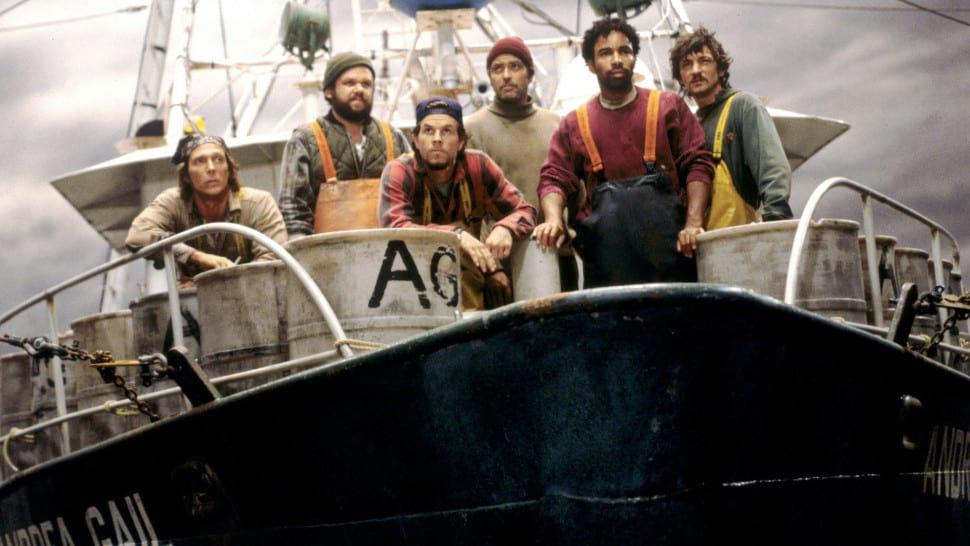
Sound and Fury: The Perfect Storm
Director Wolfgang Petersen and cinematographer John Seale, ASC, ACS, whip the sea into a frenzy.

Unit Photography by Claudette Barius, SMPSP
A mature hurricane is by far the most powerful force on earth; the combined nuclear arsenals of the United States and Russia don’t contain enough energy to feed a hurricane for even a single day. On October 30,1991, Hurricane Grace was raging approximately 300 nautical miles off the coast of Nova Scotia, fueled by another northern high-pressure extra-tropical storm, when it collided with the Gulf Stream and intensified into a meteorological anomaly that had not been recorded in more than 100 years — something the National Weather Service dubbed “the perfect storm.”
The storm, also referred to as the Halloween Nor’easter of 1991, created winds in excess of 90 knots (or 104 mph) and waves of 110 feet — the highest ever recorded. Nautical physics dictate that a single, non-breaking wave of any size is incapable of sinking a ship, but a breaking wave of 100-110 feet has enough force to crush the hull of any ship and can even flip an aircraft carrier.
The longliner fishing vessel Andrea Gail was about 300 nautical miles off the East Coast and heading back to Gloucester, Massachusetts, full of fish, when she ran straight into the perfect storm. She never reached port.
In his best-selling book The Perfect Storm, journalist Sebastian Junger chronicles the struggle of the six-man crew aboard the Andrea Gail. Teaming up for the first time to bring this tale to the screen are Academy Award-nominated director Wolfgang Petersen (In the Line of Fire, Das Boot) and Academy Award-winning cinematographer John Seale, ASC, ACS, whose credits include The Talented Mr. Ripley, The English Patient, Gorillas in the Mist and Witness. “I was very excited to come onto this project,” says Seale. “It’s an amazing true story, and I was ready and raring to make a go at telling it. Being a yachtsman myself, I wanted us to be as real as we could and not deliver a ‘Hollywoodized’ version of reality. I felt that out of respect for the fishermen who were caught in that storm and the Air National Guard boys who had to ditch their helicopter in the middle of it, we needed to give the audience a reality they would never expect.
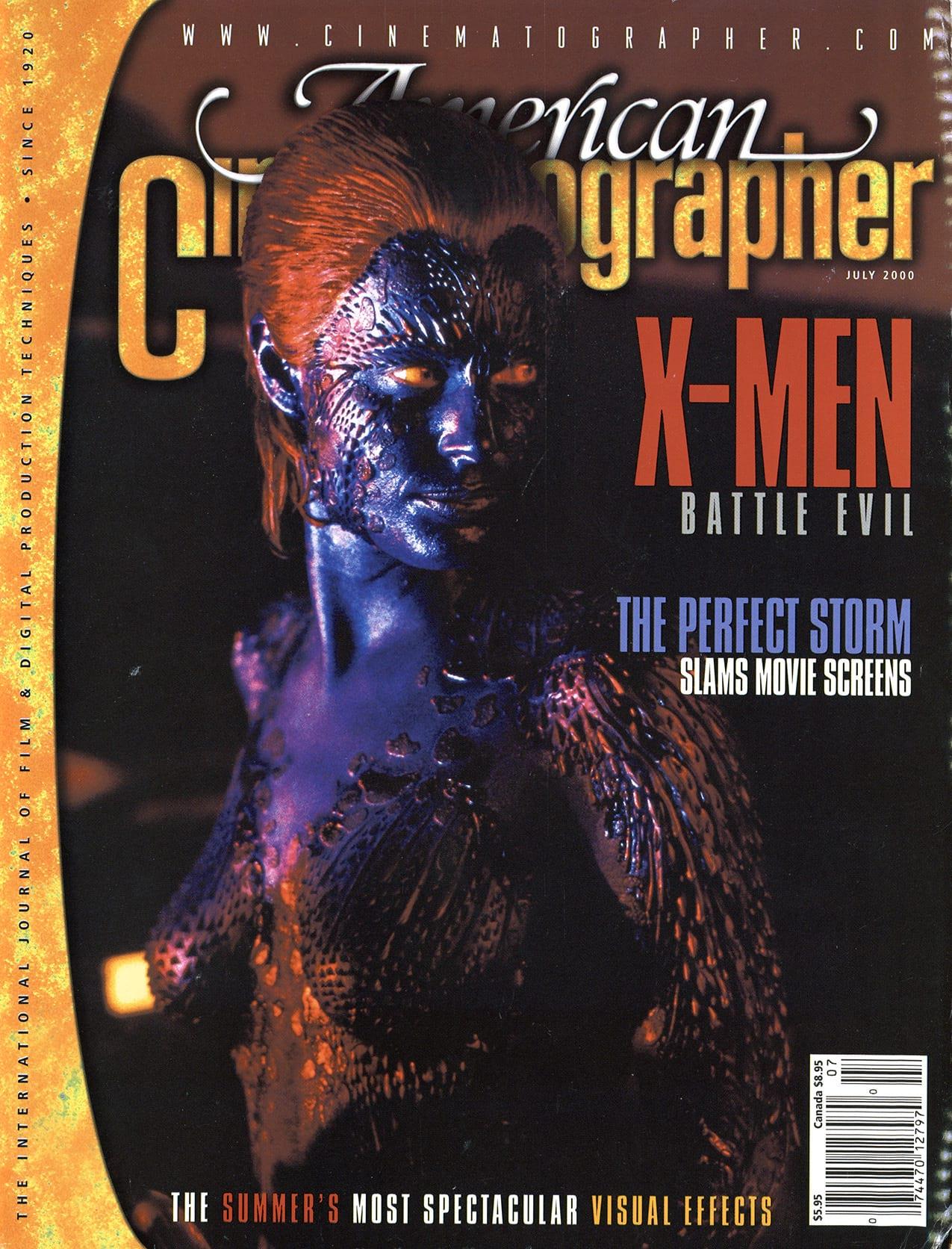
“I come from an upbringing of low-budget films, and my brain always clicks back to how to accomplish a given task in the most economical manner,” he continues. “When I read the script, I thought we should go to South Africa, to the cape of storms, wrap the camera up in a bit of plastic and go for it! I arrived at Warner Bros, ready to go off to Africa, and they looked at me as if I was on drugs. They said, ‘No, think Stage 16,’ and I said, ‘What?!’
“Of course, it all came together very quickly. I didn’t know that Industrial Light & Magic had already been doing extensive work and tests on generating three-dimensional waves on the computer. I just sat there in awe and thought, ‘We’re going to do a major, apocalyptic storm on a soundstage! That’s fantastic! The result is that all of the storm footage was shot on stage.”
Although the majority of the film’s nearly 90-minute storm sequence was fabricated on stage, the story was not entirely photographed there. Early on, the production traveled to Gloucester to shoot the film’s opening sequences at the actual wharf where the Andrea Gail had launched. While shooting there, the production was graced with the presence of a hurricane that was traveling north along the U.S. coastline. Second-unit director of photography Walt Lloyd raced out to capture footage of the real thing. “When the hurricane came up the coast,” recalls Seale, “Walt was the first one out there. He got cold and wet and was incredibly happy, and he got some terrific second-unit stuff of the Hannah Boden [Andrea Gail's sister ship] in at least 8-foot seas that were breaking over the bow.
“The problem was that the real hurricane looked like calm seas compared to the 110-foot seas that the Gail encountered in the middle of the 1991 storm! We did use the real storm sequences in the film, but we used them to represent fairly calm seas! When the first unit went out there, the seas had dropped by three or four feet, but even in just 5- to 6- foot seas everybody was sick and rolling around and saying, ‘Isn’t it rough?!’ It made us all stop and think, ‘My God! Can you imagine what 110-foot seas would be like?’ It’s truly horrifying.”

The task of re-creating a monolithic storm on stage reduced Seale to cold sweats on a number of occasions. Before Seale joined the production, Petersen worked extensively with storyboard artists to sketch out nearly every scene in the film. When the cinematographer began sitting in on meetings in Los Angeles, he remained quiet as Peterson meticulously went over the shots with the artists, methodically paring the elements down to what was necessary. “I was a little behind when I first got to Warner,” Seale confesses, “and I spent some time merely listening, trying to pick up Wolfgang’s process. I am a great believer in a cameraman doing that. I think Wolfgang might have been a bit worried that I wasn’t contributing directly right from day one, but I don’t do that. I sit and listen quietly to what the director wants, and I absorb his plan. That way, when I do jump onboard, I’ve got both feet firmly planted and I’m on the same wavelength as the director; we’re making the same film.”

When the storyboard process was completed, ILM took the boards and created animatics, which included technical information based on calculations such as lens size and camera positions. Right off the bat, Seale discovered that a number of shots simply weren’t possible within the tight confines of Stage 16. “That’s where I became very active in the overall decisions for the film,” he recalls. “This was the movie coming together shot by shot. Bill Sandell, the production designer, was handing me scale drawings of the sets and I was poring over them with a fine-toothed comb, trying to decide how we were going to do all of this.
“I quickly realized that we couldn’t do a lot of the shots we were planning! We had a small lip around the water tank, and I figured we could use Super Technocranes to get us out a good distance and give us a great deal of flexibility. However, that would only give us a 28-to 30-foot reach in each direction, for a total of about 60 feet. Some of the shots that were coming back in the animatics were moves of over 100 feet! I raced through the animatics and found a lot of shots that we simply couldn’t pull off unless we put an Akela crane on the stage, but I also realized that there would be no room to swing it around at all. About two hours into wracking my brain, I was in a deep sweat.
“I told Duncan Henderson, our executive producer, ‘We can’t do this the way we’re thinking. The shots are too big.’ The trawler was 72 feet long, the tank was 100 feet long and one of the shots started off the bow, went right down past the ship and turned around to look back over the stern — for a total of about 140 feet! We didn’t have anything that would have that kind of reach from the stage floor. We’d have had to build tracks over the water every night just to pull off a single shot the next day, and then we’d have to rip it all down again. We came to realize that the only way many of the shots would work was if we put the crane bases in the water. Our savior, Ralph Kerr, a hydraulic-engineering genius, said he could build us a platform that would float around the tank while supporting the crane, crew and everything else; when in position, it could hydraulically lift four feet out of the water to avoid the waves and be ready to shoot. He went off and built us two platforms that did exactly that. They were lifesavers, because we could put the crane bases anywhere we needed to get the shots.”

Solving the platform problem was only the first major obstacle Seale had to overcome. Throughout the course of the storm, the film tracks a half-dozen different vehicles, including Para-Rescue Jumper helicopters, a Coast Guard Cutter, a 32' sloop, the Hannah Boden and the Andrea Gail. Seale’s first concern was establishing rules for maintaining visual continuity amid the chaos of the storm. “It became a very logical process of breaking down the complexities of the sequences into numbers,” he says. “One of the first things we had to do was carefully figure out the camera and lighting continuity; I knew we couldn’t easily move around anything on the stage, so we had to have our homework done. I sat down with Wolfgang, and we agreed that the camera should always be south of the whole geographic action and looking north. That way, when the longliners leave the East Coast to go out to the Grand Banks, they’ll be traveling left to right. When they fill their hold and head back, they’ll be moving right to left. Once they get into trouble in the storm, [the rescue crafts that] come out to help will all be going left to right.
“Once we had the geographic continuity breakdown figured out, I drew up a map of the coast and waters showing where each vessel would be at any given time and which direction they would be heading. Then I could break down the scenes and know, for example, that in Scene 147 the Andrea Gail turns into the storm and punches through the waves in slightly southwestern direction, meaning she’s going right to left and coming toward camera. We’d need to position the dump tank in the lower quarter of the stage, the wind machines on the north and east walls, and the camera platforms over toward the bow a bit. It all came down to numbers — that’s the only way you can make it through that much information and that many variables and still come out on top. There was no time or money for guesswork.”
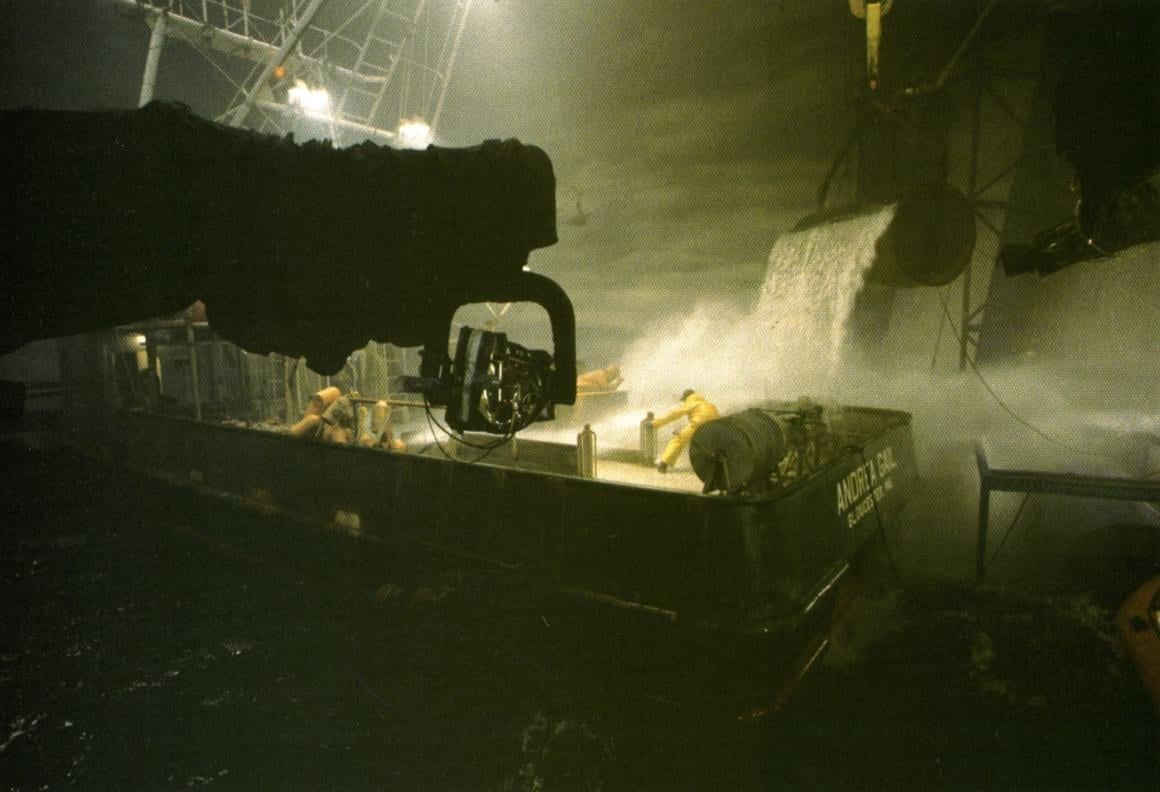
The cinematographer’s next concern was how to graphically represent the trawler’s position between crests of 100' waves in a tank only 20' deep. The boat was mounted on a custom-designed, multifaceted, six-ram super-gimbal that was able to simulate the pitching and rolling of an oceangoing vessel. To capitalize on the boat’s motion ability, Seale employed tri-axial remote camera heads from Libra on the ends of the Super Technocranes. Interpolating data from ILM’s projections, which were based on real meteorological data, Seale determined that 100' waves would have a period (or distance from crest to crest) of approximately 700'. At any given moment in the narrative, the trawler would be rising up the crest, crashing down the backside or lying momentarily in the trough between waves. “The wave machines in the tank could produce 4-foot waves,” Seale recalls. “Obviously, we couldn’t build a tank large enough to create 100-foot waves, so we used camera angles to stimulate the rise and fall of the boat. The third axis on the remote head gave us that angle. As the boat would round the crest of the wave, we would release the dump tanks to simulate the breaking water. It worked fantastically.”
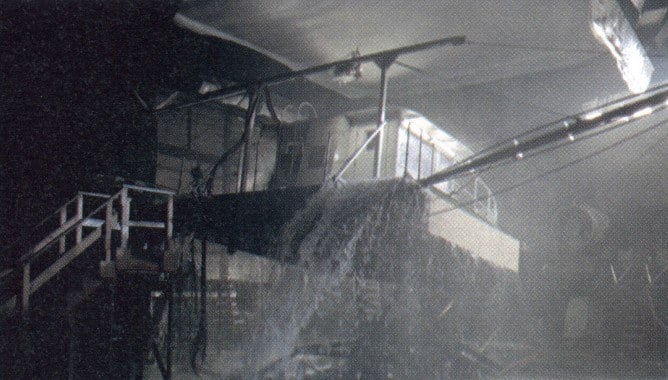
Surrounded by 2,500-gallon dump tanks, 100-m.p.h. winds, water cannons and rain machines, the actors aboard the Andrea Gail were not the only ones constantly drenched — so was the gear. From the beginning, waterproofing the equipment was of paramount concern. Seale also tried to eliminate the possibility of condensation. Compromising between that concern and the actors’ comfort, the water tank on Stage 16 was heated to 82 degrees, which helped abate temperature differentials and reduce the chance of condensation.
The cameras were also placed in waterproof housings. Because they were working off of remote heads, the sheer weight of a hard case was just not a possibility, so Seale and first assistant cameraman Trevor Loomis turned to Pete Romano at Hydroflex for the solution. Romano designed a soft-bag system for each of the cameras, and he and Loomis designed an air-curtain system for the matte box of each camera to keep water from collecting on the glass. Using two points of pressurized air, one in each corner of the box, they created double planes of air curtains, which helped keep the majority of water mist out of the mattebox and blew away the larger drops that landed on the glass. The system, unlike the rather-unwieldy and not-too-waterproof “spinner” rain deflectors, was light enough to be employed on handheld cameras as well as on the remote heads.
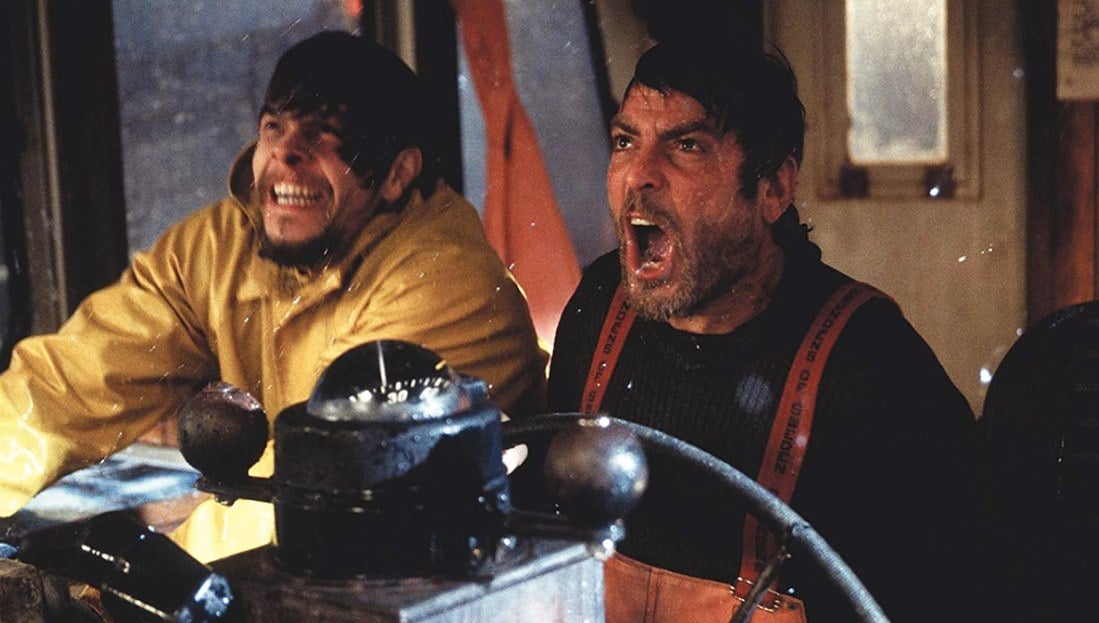
Taking the idea one step further, Loomis designed a pressurized air system inside the soft bags. Running air through filters to make sure it was absolutely dry, Loomis pumped the waterproof bags up to create a slightly-higher-than-ambient air pressure and eliminate any potential ingress of water. The system was a great success, allowing the cameras to be literally submerged without sustaining water damage.
Seale was also concerned about the extra liability of working with block batteries to power the cameras. Not only were they extra weight, but they also would have to be constantly replaced as the batteries ran down. To eliminate this inconvenience, the crew created a power-conversion system and ran AC power up the arms of the Super Technocranes that was then converted to DC voltage to serve the cameras, heads and any accessories. Further refinements allowed variable outputs of DC voltage to service a great range of power requirements.
“We booked the Super Technocranes from day one,” Seale says. “I really could not see working without them. One rule we made very early on was that we would never attach the cameras to the boats, because that would cause us to lose the frenetic energy of the boat’s movement on the water. The cameras had to be free of the vehicles so we could get the full feel of their motion. Because we didn’t want to lock the cameras down — for the safety of the actors, who were being thrown around on the gimbals — we would have to back the cameras away so that there was no danger of the actors being thrown into our gear. That meant I had to use zooms, which was no problem for me because I am a true lover of zooms! I think they’re one of the greatest inventions ever, especially the 11:1 Primo zoom. We bolted one of those on each of the cameras and just let them rust there. Occasionally, we pulled out the 5:1 zoom, but for the most part the whole film was shot with my favorite lens, the 11:1.”

Seale and Petersen also elected to shoot the film in the anamorphic format, which created its own set of considerations. The anamorphic zooms would be considerably slower than spherical zooms or primes, and there was also significant concern regarding focus because the entire film would be photographed primarily wide open at a T4.5. “I opted to shoot anamorphic rather than Super 35 because I felt the quality improvement was a significant advantage for this film,” Seale asserts.
“It made things a bit more difficult, however, because I had to light everything up. I just said to the guys in pre-production, ‘Your stop is T4.5. Lock it off!’
The 8-perf VistaVision cameras from ILM were all T4.5 as well, so the whole film was planned for that stop.
“Trevor Loomis and Cal Roberts [the show’s A- and B-camera first assistants, respectively] pulled off the impossible,” Seale continues. “We would be wide open on a 550mm anamorphic lens, shooting close-ups of guys being thrown around a gyrating ship while the camera was swinging around on a Super Technocrane, and the shots came back sharp. Their concentration was incredible — under rather impossible conditions. Of course, we drove the actors crazy to get focus marks; Trevor would tell the gimbal operator we needed marks, and the operator would swing the boat over to its far extremes, which could sometimes be as much as an 18- to 20-foot arc! Actors like George Clooney helped make their jobs a bit easier, though. He was very disciplined; he’d say, ‘This is my mark, this is where I’m going to be,’ and he’d be there consistently. That type of precision, which isn’t as commonplace as it should be, helps take a bit of the strain off the focus pullers.”
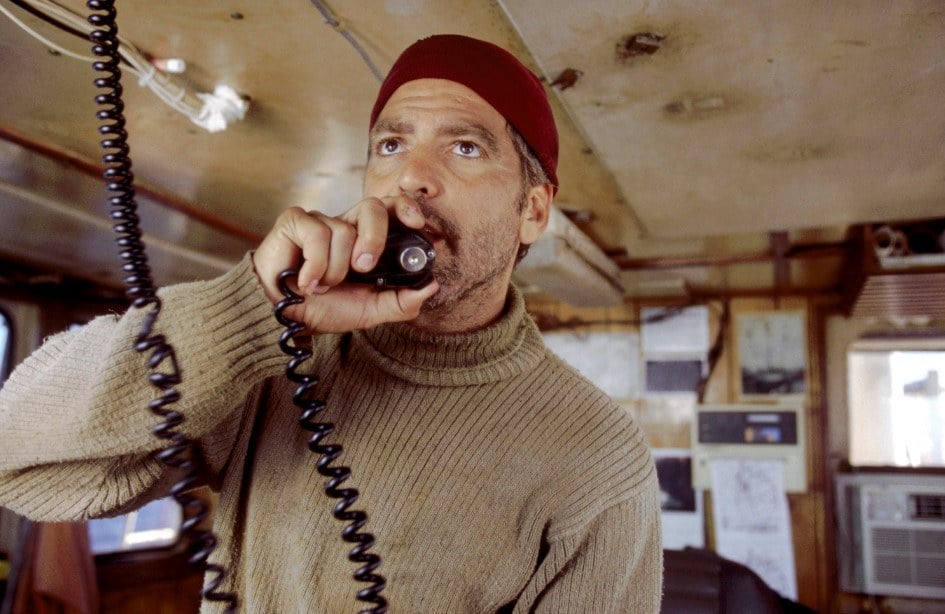
Because of the massive amount of bluescreen photography and CGI work that was necessary to complete The Perfect Storm, the team at ILM — under the supervision of Stefen Fangmeier (see visual effects story in AC, July 2000) — required the use of Eastman Kodak’s SFX 200, an emulsion with an improved red layer specifically engineered for traveling matte compositing. To help a bit with emulsion speed, Seale force processed the SFX 200 one stop, rating it at 320 ISO, and turned to Kodak’s EXR 200T (5293) for shots that did not require bluescreen work. This was a bit of a departure from Seale’s normal repertoire, which consists primarily of Kodak’s 500T emulsions (EXR 5298 and Vision 5279). Toward the end of production, Seale did turn to his old favorite, Vision 500T (79), over the EXR 200T (5293), rating the 79 at 400 ISO and gaining an extra one-third stop of speed.
Even at 400 ISO, a T4.5 requires a fair amount of light. In addition, the stage was going to be used for situations ranging from bright sun to the gloom height of the storm and for night, and Seale was determined to hang a versatile plot that would allow fairly seamless changeovers from one look to the next. To achieve this, gaffer John Carney and key grip Bill Young rigged a large 80' x 80' soft light to the perms in the stage, and also stuffed in some 89 10K SkyPans assisted by a ring of double 20K soft boxes (see lighting plot below) to get the base stop, at full intensity, of T8 at 200 ISO. This large coop source created a soft, overall flat toplight that was perfect for Seale’s needs.

“The look was, in one word, reality,” Seale affirms. “It’s a true story, and I felt we should all set out to create the awesome reality of an ultimate storm. Also, the logistics of shooting meant that every light that went in to light an actor was a major ordeal: it had to be waterproof and it had to be hidden from two or more cameras in tightly confined spaces. It just made each light a nightmare. Adding little flourishes like a backlight or a kicker was a major task, so I just didn’t put them in. I went flat.
“Realistically, midday in the middle of a storm is very flat lighting, and considering the economics and reality of shooting this logistically monstrous film, I decided to forego a lot of the small touches that cameramen love to do. I opted for portraying raw nature. We did have to cheat a bit here and there; for example, the wheelhouse of a ship at night doesn’t have any lights at all — they would blind the helmsman and ruin his night vision — but in a movie you have to be able to see, so we cheated by adding the glow from instruments or a movie moon. In the trawler with Clooney and his band of fishermen, we cheated the light from down below in the crew’s quarters so it would throw a glow up the stairway and provide some light in the wheelhouse. For the most part, though, we went for reality.

“I’ve taken that approach with a lot of my films, although this was admittedly a new extreme. I love reality lighting. I love the fact that an audience can sit through a film and feel comfortable in the security of visual reality. If the story is a horror story, the horror is that much more [effective] because it all looks real. For The Perfect Storm, we were going for exactly that [feel].”
In addition to extensive bluescreen work — and perhaps in homage to Seale’s low-budget mindset — the production used to a number of “poor man’s-process” sequences, using large, painted backdrops in place of the bluescreen behind the gimbaled boat. Four different backdrops (each 60' high x 200’ wide) were rigged on an extensive traveler system across the back corner of the stage. The #1 backdrop was painted to emulate bright and happy skies, #2 was the deepening storm, and #3 was what Seale called the height of the “apocalyptic storm.” The fourth drop was painted to emulate deep night during the storm, and Seale used several 70K Lightning Strikes units, along with a prototype 40K Lightning Strikes Par, to augment the CG lightning that ILM would add into the painted backdrop.
Peterson, however, refused to classify these sequences as poor-man’s process. Laughing, Seale explains, “Considering the expense of putting each of these shots on film, he felt that we had moved into the ‘middle-class process’ category, and that’s what we called it from then on. ILM even started identifying sequences as ‘MC’ shots. I think Wolfgang may have invented a new term!”
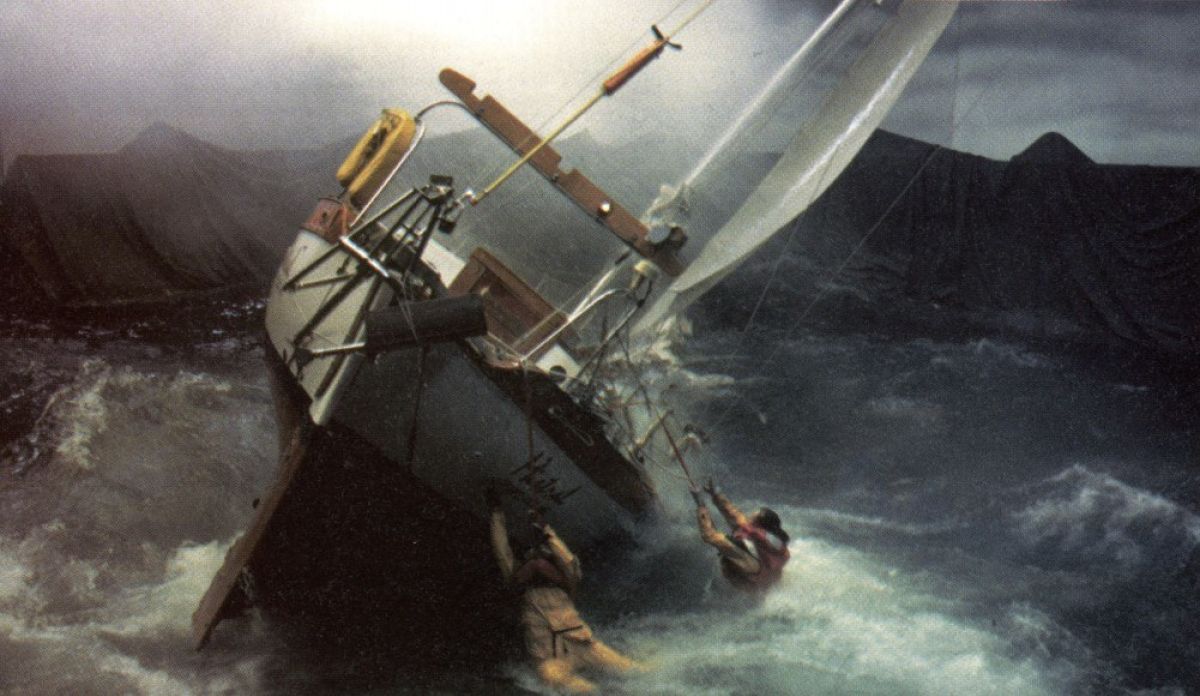
The trendsetters on The Perfect Storm utilized every means at their disposal to work efficiently and economically and keep the film’s $100 million budget under control. Toward that end, the production kept the soundstages working 24 hours a day. The first unit would work from 7 a.m. to 7 p.m., while the second unit would toil from 7 p.m. to 7 a.m. “Duncan Henderson, being the great producer that he is, decided to keep the stages rolling all day long, and it was a fantastic way to work,” Seale submits. “It enabled the second unit to jump onto their shots hand-in-hand with the first unit. They weren’t waiting six, seven or eight weeks until the stage was available to come in and pick up their shots; they were shooting right along with us. That also meant that [if we ran across] anything during the day that could be swept over to second unit, they would simply pick it up that night with fresh notes from us. In many cases, they had a hot set to work with.
“That also meant that the editor was getting first- and second-unit dailies at the same time, which enabled him to cut together nearly final sequences right off the bat. At the end of our night, we’d turn the stage over to Walt Lloyd and his boys. They would shoot what was on their slate and whatever shots we swept to them during the day, and then rough in our vehicles and lighting so that the first unit would be ready to shoot from the get-go the next morning. We were one well-oiled machine rolling toward that release date!”
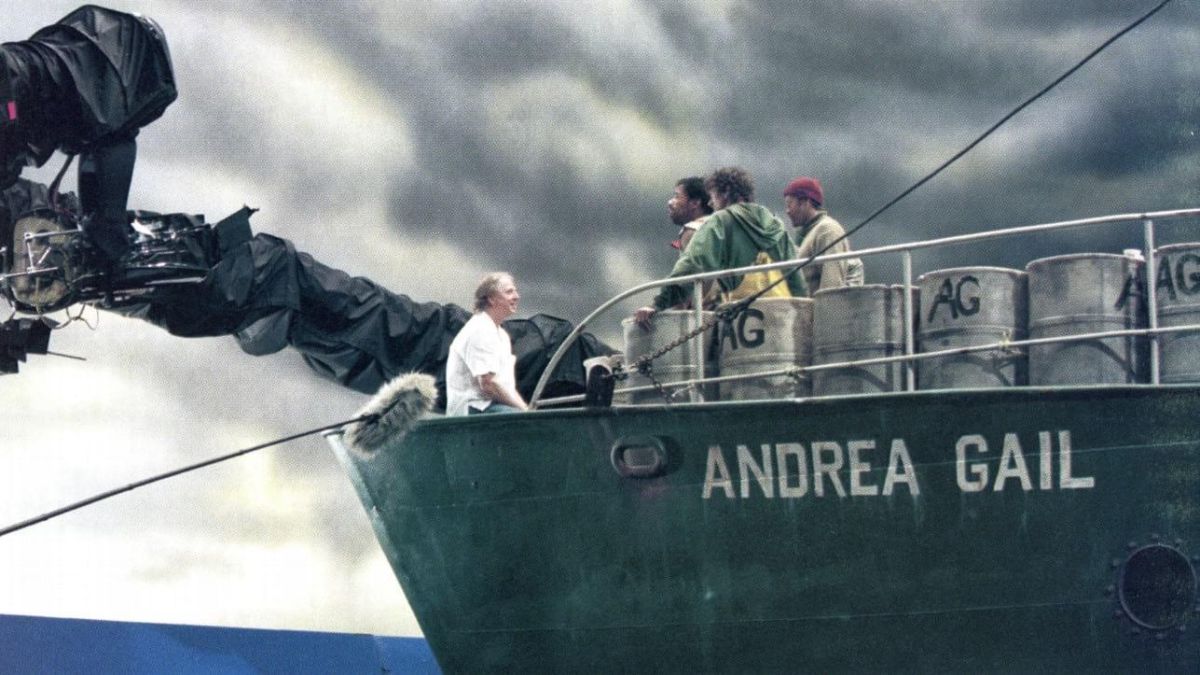
The final scene of the film takes place in a cathedral, where a memorial is held for the crew of the Andrea Gail. Striving for authenticity, the production chose to shoot on location in Gloucester. A high-ceilinged cathedral with Gothic, stained-lead windows presented Seale with a bit of a challenge. “It was difficult to light because the windows were very thick,” he recalls. “We poured as much light through them as we could, but in the end it wasn’t enough, and nature didn’t allow the sun to be on the right angle to give us any help.
“This was the one location where I wanted a bit of heightened realism. We’ve gotten out of this horrible storm, and I felt we needed a lift at the end. I wanted to get some shafts of light coming through the stained windows, but the 6Ks and 18Ks that we put up on cherrypickers outside just weren’t doing the job. In a slight panic at the last moment, the boys rallied together and we set up a number of 1200-watt Pars inside the church, hiding them behind pillars to give us the beams we were looking for. We also bounced three or four 6K HMIs into a little, angled roof return up near the altar to bring up the overall ambience in the room and create the feeling of some sunlight. I wanted to give the audience a chance to come up for air and breathe a bit before going home.”
Seale confesses that he was overcome by a bit of “temporary insanity” at the outset of production. “Like a madman, I insisted rather vehemently that we would get eight to 10 shots per day. Everybody looked at me like I had lost my mind — this, on top of the fact that I wanted to go to Africa and brave the storms! I’m sure many of them thought I was just very sad. But I was insistent, and after a while people said, ‘It’s a crazy idea, but okay, let’s go for it!’
“We never did achieve that goal, and with the complexity of every shot, we never really could have,” Seale concludes. “But every shot we did was fantastic, and I truly believe that gigging everybody up at the beginning of production helped to create a wonderful source of energy that we all kept up throughout shooting.”
Lighting Plots for The Perfect Storm
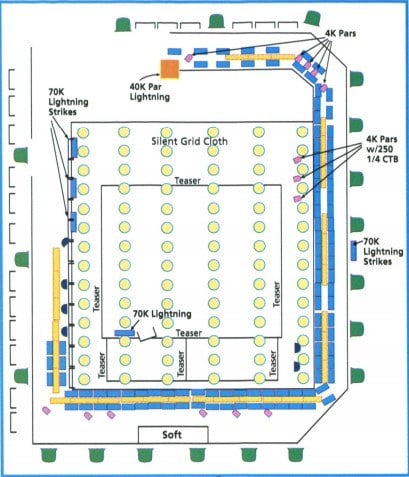
Second assistant camera and documentarian Heather Scobie was given the monumental task of recording lighting positions, camera movement and general camera continuity notes for each sequence in the film.
"This diagram was of scene 157," Scobie offers, "which was during the height of the storm. George [Clooney] must climb out onto the ship's outrigger to cut loose the sea anchor, which is flying around in the wind and ripping apart the boat.
Overall on Stage 16, John [Seale] created a general soft wash with 89 10K Sky pans through an 80'x60' silent frost diffusion and highlighted specific areas with 20K Fresnels from the perms [shown on the inset diagram]. For this particular shot, the #3 storm drop was placed on the back wall [from bottom along right hand side of page over the bluescreen], and the Image 80s were not used. John also had a fiber-optic acetylene torch rigged up for George to carry with him, and used the MR-16 at the end of the outrigger to create some interactive lighting for that effect.
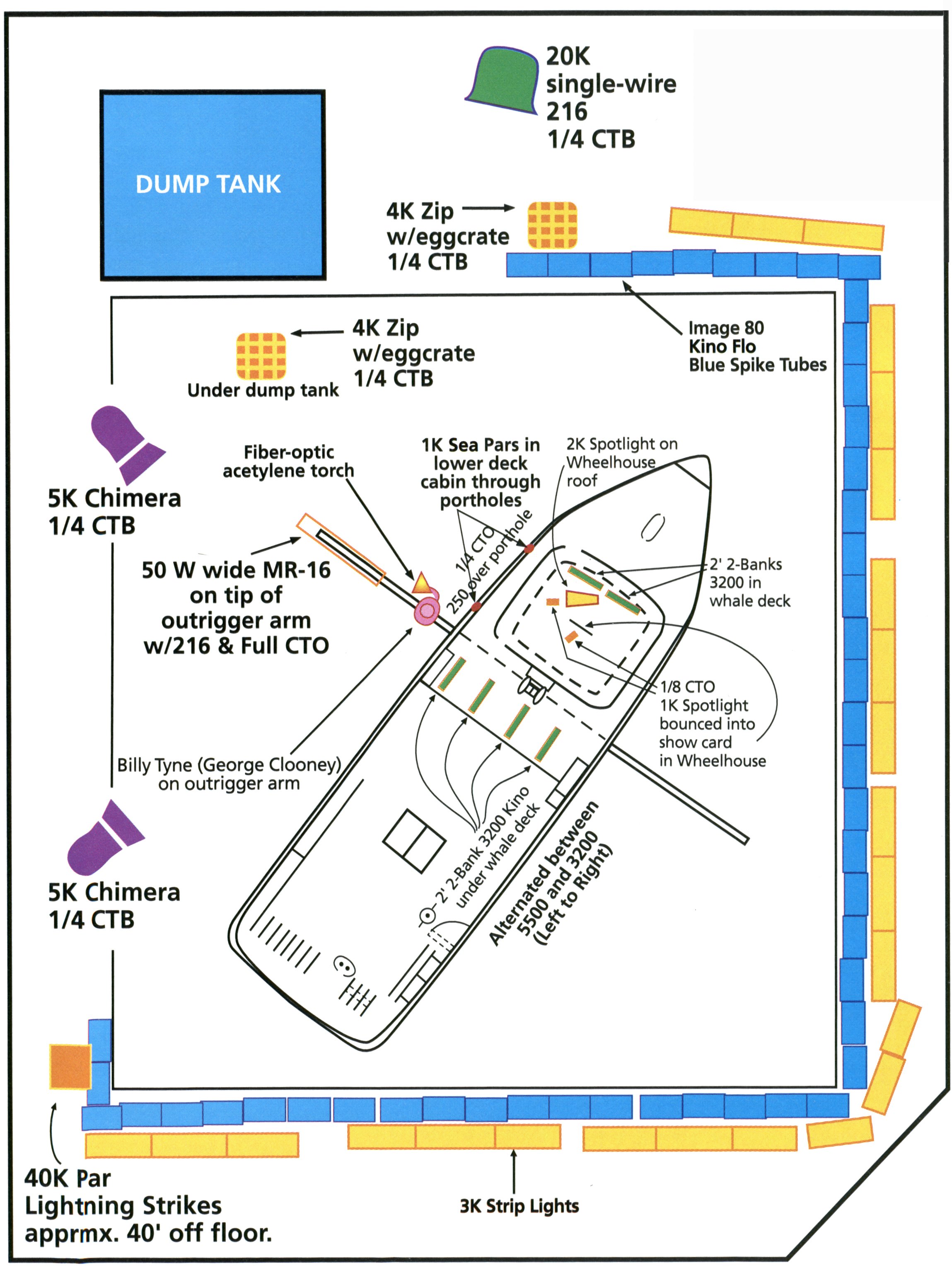
Second-unit cinematographer Walt Lloyd would later be invited to join the ASC.



